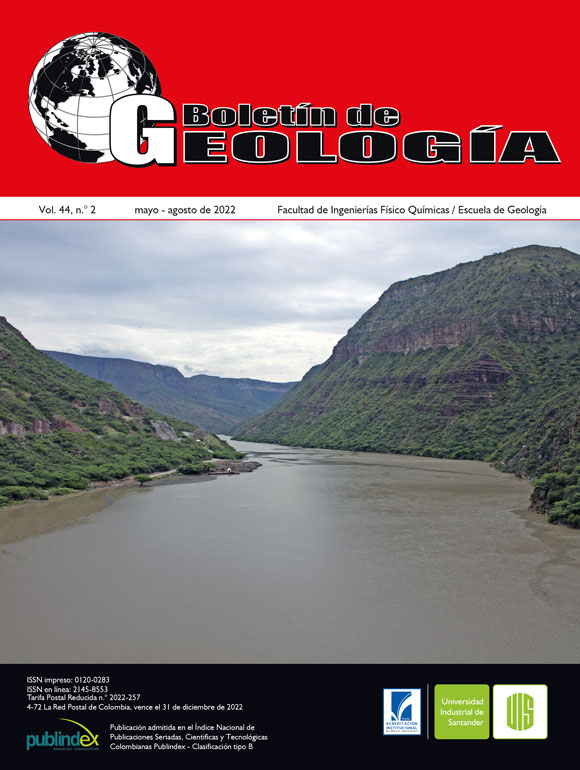Determination of turning angle for extraction of plugs from preserved cores using X-ray images tomography
Published 2022-07-07
Keywords
- Plugs,
- X-ray tomography,
- Nomogram,
- Drilling core,
- Turning angle
How to Cite
Copyright (c) 2022 Boletín de Geología

This work is licensed under a Creative Commons Attribution 4.0 International License.
Altmetrics
Abstract
The plugs are subsamples extracted from drilling cores, which are used to measure directly the properties associated with the rock and its interactions with the fluid. Any petrophysics model must have laboratory data from the samples to be calibrated. Due to this, it is important that samples are representative and in a good condition. This research proposes a methodology to determine exactly the location of interest points, including the turning angle of the core for its further extraction. This guarantees the integrity and representativeness when the interest zone is selected through well logging. The methodology uses X-ray tomography images on axial, radial, and vertical cuts. It was possible to create equations to measure in scaled images the real dip angle in the cylindric images and vertical cuts. It was also possible to create two nomograms that allow calculating the turning angle of the drilling core, once the dip data of the interest structure is calculated.
Downloads
References
- Chakraborty, M.; Mukherjee, S. (2020). Structural geological interpretations from unrolled images of drill cores. Marine and Petroleum Geology, 115. https://doi.org/10.1016/J.MARPETGEO.2020.104241
- Germay, C.; Richard, T.; Mappanyompa, E.; Lindsay, C.; Kitching, D.; Khaksar, A. (2015). The continuous-scratch profile: a high-resolution strength log for geomechanical and petrophysical characterization of rocks. SPE Reservoir Evaluation & Engineering, 18(03), 432-440. https://doi.org/10.2118/174086-PA
- Goldfinger, C.; Morey, A.E.; Black, B.; Beeson, J.; Nelson, C.H.; Patton, J. (2013). Spatially limited mud turbidites on the Cascadia margin: Segmented earthquake ruptures? Natural Hazards and Earth System Sciences, 13(8), 2109-2146. https://doi.org/10.5194/nhess-13-2109-2013
- Honarpour, M.M.; Cromwell, V.; Hatton, D.; Satchwell, R. (1985). Reservoir rock descriptions using computed tomography (CT). SPE 60th Annual Technical Conference and Exhibition, Las Vegas, USA. https://doi.org/10.2118/14272-MS
- Jarrard, R.D.; Vanden Berg, M.D. (2006). Sediment mineralogy based on visible and near-infrared reflectance spectroscopy. Geological Society, London, Special Publications, 267, 129-140. https://doi.org/10.1144/GSL.SP.2006.267.01.09
- McPhee, C.; Reed, J.; Zubizarreta, I. (2015). Best practice in coring and core analysis. In: Core Analysis: A Best Practice Guide (pp. 1-15). Chapter 1. Vol. 64 ELSEVIER. https://doi.org/10.1016/B978-0-444-63533-4.00001-9
- Nederbragt, A.J.; Dunbar, R.B.; Osborn, A.T.; Palmer, A.; Thurow, J.W.; Wagner, T. (2006). Sediment colour analysis from digital images and correlation with sediment composition. Geological Society, London, Special Publications, 267, 113-128. https://doi.org/10.1144/GSL.SP.2006.267.01.08
- Ortiz-Meneses, A.F.; Plata-Chaves, J.M.; Herrera-Otero, E.; Santos-Santos, N. (2015). Caracterización estática de rocas por medio de tomografía computarizada de rayos-X TAC. Revista Fuentes, El Reventón Energético, 13(1), 57-63. https://doi.org/10.18273/revfue.v13n1-2015005
- Rothwell, R.G.; Rack, F.R. (2006). New techniques in sediment core analysis: an introduction. Geological Society, London, Special Publications, 267, 1-29.
- https://doi.org/10.1144/GSL.SP.2006.267.01.01
- Siddiqui, S.; Khamees, A.A. (2004). Dual-Energy CT-scanning applications in rock characterization. SPE Annual Technical Conference and Exhibition, Houston, USA. https://doi.org/10.2118/90520-MS
- Tavakoli, V. (2018). Preparing for Analysis. In: Geological Core Analysis (pp. 15-27). Springer, Cham. https://doi.org/10.1007/978-3-319-78027-6_2
- Tucker, M.E. (1988). Techniques in Sedimentology. Blackwell Scientific Publications.
- Victor, R.A.; Prodanovic, M.; Torres-Verdín, C. (2017). Monte Carlo approach for estimating density and atomic number from dual-energy computed tomography images of carbonate rocks. Journal of Geophysical Research: Solid Earth, 122(12), 9804-9824. https://doi.org/10.1002/2017JB014408
- Wang, S.Y.; Ayral, S.; Gryte, C.C. (1984). Computer-assisted tomography for the observation of oil displacement in porous media. Society of Petroleum Engineers Journal, 24(01), 53-55. https://doi.org/10.2118/11758-PA
- Wefer, G.; Berger, W.H.; Bijma, J.; Fischer, G. (1999). Clues to Ocean History: a brief overview of proxies. In: G. Fischer, G. Wefer (eds.). Use of Proxies in Paleoceanography (pp. 1-68). Springer. https://doi.org/10.1007/978-3-642-58646-0_1
- Wellington, S.L.; Vinegar, H.J. (1987). X-Ray Computerized Tomography. Journal of Petroleum Technology, 39(08), 885-898. https://doi.org/10.2118/16983-PA

